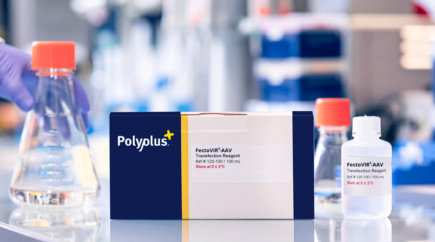Available at research and GMP grade to intensify production of recombinant AAV rAAV viral vectors at any scale from benchtop to 2000L scale bioreactor...

The development of robust, scalable, cost-effective processes that yield high titers of high-quality viral vectors will be crucial to the successful commercialization of safe and efficacious gene therapies that require large and/or multiple doses to treat more prevalent diseases. This topic was explored in a panel webinar discussion hosted by Cell & Gene Therapy Insights in which I shared, along with experts in the field from industry and academia, including Dr. Timothy Cripe (Nationwide Children’s Hospital), Lenore Giannunzio (Andelyn Biosciences), thoughts regarding best practices for successful suspension-based viral vector manufacturing scale-up. This blog summarizes the main points that we made with respect to recent developments in viral vector manufacturing, the need for rapid analytical tests for process development, the importance of designing quality into processes from the outset, the value of early and open collaboration with outsourcing partners, and the benefits of planning early for long-term success.
 |
Alengo Nyamay’antu, Ph.D. is the Scientific Communication & Marketing Team Leader at Polyplus. She completed her PhD in Biochemistry from The University of Manchester, followed by a postdoctoral position in molecular Biomedicine at the Max-Planck Institute, before joining Polyplus® in 2016. |
Gene therapy is still a nascent field, and manufacturing practices continue to evolve as the sector slowly matures. Think about monoclonal antibodies (mAbs). Initial titers were quite low but have been increased over a couple of decades by many magnitudes. Production of viral vectors is similarly evolving—perhaps even at a faster pace.
Several advances have already contributed to improvements in viral vector yields. The availability of single-use, integrated solutions allow for much greater process control while minimizing the contamination risk. There are also significant, active, ongoing efforts to generate stable producer cell lines that have the promise of producing high vector titers with more consistent and higher product quality.
Newer transfection reagents purposefully designed for viral vector production are affording improved transfection efficiencies. At Polyplus, we’ve specifically developed FectoVIR®-AAV and FectoVIR®-AAV GMP transfection reagent to support AAV production in suspension cell culture and are already helping enable simpler process scaling up to 2000 L.
Download large scale AAV manufacturing guidelines
Application of a targeted design of experiment (DoE) approach to viral vector process development is also contributing to improvements in vector manufacturing processes. There are many parameters that influence vector capsid formation in addition to the transfection reagent, including the quality and nature of the plasmid DNA (pDNA), the ratios of different plasmids, the plasmid-to-transfection reagent ratio, the transfection complex transfer rate, and of course temperature and other process conditions.
A targeted DoE approach starts with setting an acceptable process performance level, which helps to avoid spending too much time seeking diminishing returns. The second component is to explore multiple factors simultaneously to identify optimum values and also establish the process design space. Investing in such DoE studies in scale-down models at the beginning of a gene therapy program can have significant benefits in terms of process efficiency as well as vector yields and quality.
One of the challenges viral vector manufacturers currently face is the need to repurpose existing manufacturing equipment and solutions that were originally developed for the production of traditional biologics. Fortunately, vendors are now creating solutions specifically designed for gene therapy processes. Innovations in all aspects of the process, from producer cell lines to transfection reagents to bags and bioreactors will all help increase the scalability and productivity of viral vector processes. Greater understanding of the biology of the cells used for viral vector manufacturing will also lead to improved titers and—equally important— increased production of functional virus, both of which will prove to be extremely beneficial for patients.
One of the most important contributors to successful scaling of viral vector processes is designing for quality from the outset. Selection of the optimal production system is extremely important and has huge implications for the road map to and timeline for commercial manufacturing. Specifics include the serotype and vector design, the size and sequence of the transgene, and selection of the production platform, including the specific equipment and reagents. All of these factors influence productivity, potency and quality.
It is equally important to have good analytical assays that provide reliable results to ensure that safety, potency and quality requirements are met. Processes should also be designed with the ultimate manufacturing scale in mind. Many of the small-scale processes developed to date have involved limited planning for scalability, particularly those coming from academic laboratories. If scaling is not factored into the process design, then often large shifts in operating parameters will be required as processes scale, which can in turn require significant technical changes to enable manufacturers to meet the demand of the patient population.
It is therefore important to evaluate not only critical process parameters (CPPs) that impact product quality, but also key scale-dependent parameters, such as shear stress, mixing rate, transfection volumes and peak overall process volumes.
The best way to achieve this is to use high-quality, fit-for-purpose reagents. DNA plasmids must be precisely designed for the specific target viral vector and gene therapy application. Poor-quality pDNA can lead to low transfection efficiencies and the production of high levels of impurities, including protein contaminants. Plasmid design, meanwhile, affects packaging quality, specifically whether or not the gene of interest (GOI) is properly inserted into the vector particle. If the pDNA design is not appropriate, it is possible to have DNA lengths that are too large or small contained in the viral capsids. All of these issues have a direct impact on the number of purification steps required and make it increasingly difficult to obtain pure vector products.
Another component of designing for quality involves relying heavily on data to drive decision making. For instance, Andelyn Biosciences’ viral vector suspension manufacturing platform was developed by designing quality in at the small scale for ultimate large-scale performance. In addition, more than 100 runs were performed at the 50 L, 100 L and n200 L (with the assistance of Pall’s Process Development Services team. The data collected at each scale was used to further refine the process, resulting in process dynamics that are as robust as possible for many different serotypes. Even with this platform, targeted DoE studies are performed for each specific product to make adjustments to ensure maximum process optimization.
Most viral vector production processes are not developed within a vacuum. Small and emerging biotech companies rely heavily on CDMOs with expertise in the development, manufacturing and regulatory aspects of gene therapies. Even large pharma companies that have inhouse capabilities still depend on reagent and technology vendors and regulators.
Integrating novel solutions developed by vendors such as Polyplus and technical accelerators such as the Process Development Services team at Pall within the applicable regulatory framework as early on as possible is necessary to ensure that the developed process is sufficiently robust through all expected scales. Access to scale-down models (using closed, single-use systems), not only enables DoE studies, it also allows for easier troubleshooting and faster problem resolution. In addition, having more robust processes developed from the outset leaves more time for engineering and quality runs.
contact our DOE support service
Achieving that high level of integration is not possible unless collaborations with knowledgeable partners are initiated very early in a project. Working with partners that have experience and expertise in viral vector manufacturing can significantly accelerate process development and scaling. This is particularly true when quality-by-design principles are employed even though there is a lack of extensive historical data for viral vectors. Access to better (more accurate) analytical assays with shorter turnaround times will further accelerate the development process.
It is important to realize that while initial gene therapy developers were scientists with deep knowledge in virology and biology and a good understanding of regulatory CMC (chemistry, manufacturing and controls) expectations, the successes achieved with early approved products has led to an expansion of the field. Today, there are people involved that have been self-educated about vector biology but are not very savvy about CMC issues and regulatory expectations as well as those that lack knowledge about both aspects of gene therapy development and viral vector manufacturing.
For the latter two groups, working with an experienced CDMO is absolutely essential, and early collaboration is the best mechanism for enabling informed decision making and rapidly moving projects from discovery to the clinic. Starting early and maintaining frequent and open communication will ensure that the specific needs of the particular GOI, vector and intended application (including dosing requirements) are taken into account from the start. It is only possible to thoroughly identify all of the important parameters that should be tested and validated with early and close cooperation and collaboration.
Many of the analytical methods used to characterize viral vectors and assess their quality and purity are complex and lengthy to develop. Droplet digital polymerase chain reaction (ddPCR) methods are the new standard for quantitation of vector genomes. However, a customized method must be established for each transgene and serotype, and it takes time to develop these methods and then transfer them to an outsourcing partner.
The need to develop ddPCR methods upfront before projects are initiated with contract development and manufacturing organizations (CDMOs) significantly extends process timelines. Within the industry, alternative methods to ddPCR that can be used during process development are being explored to allow for analytical method development of ddPCR methods required for product release to happen in parallel to process development.
Fortunately, available methods can demonstrate that the same material is being produced from batch to batch and as viral vector processes are scaled from the lab to commercial. Techniques such as high-performance liquid chromatography, capillary electrophoresis, dynamic light scattering are a few that can be used to sufficiently demonstrate quality and uniformity in a process.
Suspension cell culture for viral vector production is highly complex, and outcomes are influenced by a multitude of factors. As such, there is no “silver bullet” for ensuring successful scale up of these processes. There are some key steps that can be taken, however, to dramatically increase the likelihood of success.
First, it is extremely beneficial to plan for scalability as early as possible. Identifying the steps and operations that impact processes at manufacturing scale, including operating parameters, equipment, reagents, and so on, when developing the initial lab-scale process is vital. This approach should be used for both the upstream and downstream. The end-to-end process must be considered and risk assessments conducted several times throughout the development scaling process.
Download large scale AAV manufacturing guidelines
Second is finding a good scale-down model that allows for optimization of process parameters for plasmid manufacturing and the transfection step. Use of such models can ensure a smoother and more streamlined scale up because the process performance at larger scale should be similar to that observed at small scale in terms of productivity and the quality of the viral vectors, eliminating the need to conduct additional small-scale optimization experiments.
Finally, selecting materials in the research setting that will be available in GMP grade can greatly contribute to more accelerated process scaling. Gene sequences, media additives, column resins, cell banks, transfection reagents, etc. all should ideally be of GMP quality from the outset, as using a research-grade material that is not available with the appropriate quality and quantity for GMP production can have significant impacts. The supplier may be able to custom manufacturer the material in GMP grade, but at a high cost with licensing ramifications. In the worst-case scenario, the GMP version may simply not be available, which requires redevelopment of the process, adding both time and cost.
Note: this article was adapted from an online roundtable discussion hosted by Cell & Gene Therapy Insights on September 7, 2022.